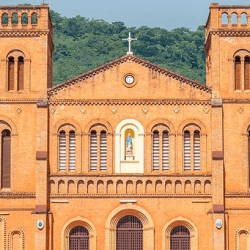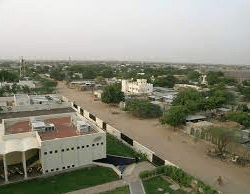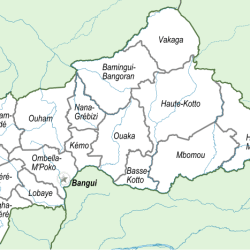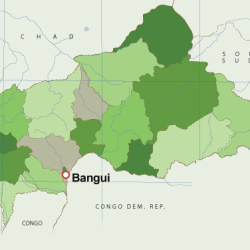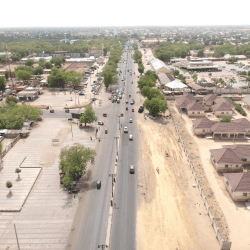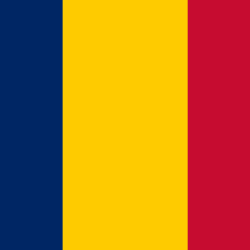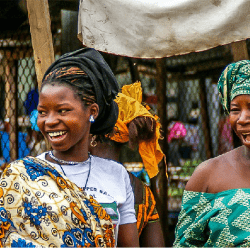Chad is located between 7° and 24° north latitude and 13° and 24° east longitude. It is the link between the Maghreb and Central Africa. Covering 1,284,000 km2, Chad is the 5th largest country in Africa after Sudan, Algeria, the Democratic Republic of Congo and Libya.
It shares borders with Libya to the north, Sudan to the east, Cameroon, Niger and Nigeria to the west.
Due to its geographical position, south of the Tropic of Cancer and in the heart of the African continent, Chad is marked by an increased continentality, of which the economic slump is one of the consequences.
It is a country that is doubly landlocked from within and from without.
Externally, Chad has no outlet to the sea. Harcourt Port in Nigeria, the nearest port, is 1,700 km from N’djamena, the capital. At the internal level, Chad has only 664 km of permanent asphalt roads and 1,609 km of permanent modern earth roads (Chad, 2005), and communications between the different parts of the country are sometimes difficult or impossible for several months because of rain-fed floods, which make some of them impassable. In general, the best route for heavy products is by inland waterway. The country’s two rivers, the Chari and the Logone, are the main river arteries, but there is the problem of water levels between the dry and rainy seasons. In the dry season, these rivers are paralyzed to navigation.
Chad has a succession of climates: Sudanian in the south with a semi-humid tropical regime, then gradually Sahelian and Saharan.
Republic of Chad
The Republic of Chad is a country in Africa. The landlocked country is bordered by Libya to the north, Sudan to the east, the Central African Republic to the south, Cameroon to the southwest, Nigeria to the southwest (at Lake Chad), and Niger to the west.







Chad has a population of 16 million and 1.6 million live in the capital and largest city of N’Djamena.
With a total area of about 1,284,000 km2 (496,000 sq mi), Chad is the 5 largest country in Africa and the 20 largest in the world by area.
Capital: N’Djamena
Independence day: August 11, 1960
Calling code: +235
Currency: CFA franc (XAF)
Official language: French, Arabic
Area: 1,284,000 km2


It is home to over 200 different ethnic and linguistic groups.
Islam (55.1%) and Christianity (41.1%) are the main religions practiced in Chad.
Chad is largely a semi-desert country. It is rich in gold, uranium and petroleum.
It became an oil-producing nation in 2003, with the completion of a $4bn pipeline linking its oilfields to terminals.
Despite its abundant resources, Chad is still faced with poverty and food insecurity. Close to half of the population (47%) lives below the poverty line.
The country ranks the 2nd lowest in the Human Development Index, with 0.394 in 2021 placed 190th, and is one of the poorest and most corrupt countries in the world.
Most of its inhabitants live in poverty as subsistence herders and farmers.
Since 2003 crude oil has become the country’s primary source of export earnings, superseding the traditional cotton industry. Chad has a poor human rights record, with frequent abuses such as arbitrary imprisonment, extrajudicial killings, and limits on civil liberties by both security forces and armed militias.
Chad’s post-independence history has been marked by instability and violence, mostly from tension between the mainly Arab-Muslim north and the predominantly Christian south.
However, it suffers from inadequate infrastructure, and internal conflict with rebels in the north, exacerbated by a jihadist insurgency across the Sahel region and Lake Chad Basin.
Regions
Chad has 23 regions, Departments and Sub-prefectures.
The subdivision of regions came as part of the decentralization process when the government abolished the previous 14 prefectures.
The regions of Chad are:
- Bahr el Gazel
- Batha
- Borkou
- Chari-Baguirmi
- Ennedi-Est
- Ennedi-Ouest
- Guéra
- Hadjer-Lamis
- Kanem
- Lac
- Logone Occidental
- Logone Oriental
- Mandoul
- Mayo-Kebbi Est
- Mayo-Kebbi Ouest
- Moyen-Chari
- N’Djamena (capital)
- Ouaddaï
- Salamat
- Sila
- Tandjilé
- Tibesti
- Wadi Fira
Ethnic groups
Chad has more than 200 distinct ethnic groups. In the south live sedentary people such as the Sara, the nation’s main ethnic group, whose essential social unit is the lineage. In the Sahel sedentary peoples live side by side with nomadic ones, such as the Arabs, the country’s second major ethnic group. The north is inhabited by nomads, mostly Toubous.
The ethnic composition of Chad, based on 2009 Census, is as follows:
- 26.6% Sara
- 12.9% Arab
- 8.5% Kanembu
- 7.2% Masalit
- 6.9% Toubou
- 4.8% Masa
- 3.7% Bidiyo
- 3.7% Bulala
- 3.0% Maba
- 2.6% Daju
- 2.5% Mundang
- 2.4% Gabri
- 2.4% Zaghawa
- 2.1% Fula
- 2.0% Tupuri
- 1.6% Tama
- 1.4% Karo
- 1.3% Bagirmi
- 1.0% Masmaje
- 2.6% other Chadian
- 0.7% foreign
